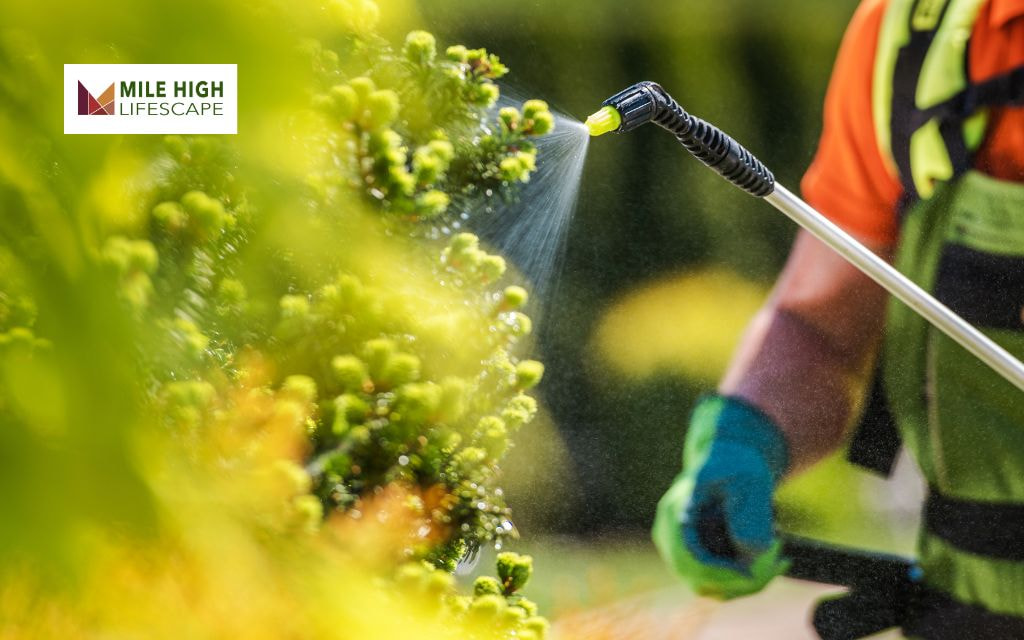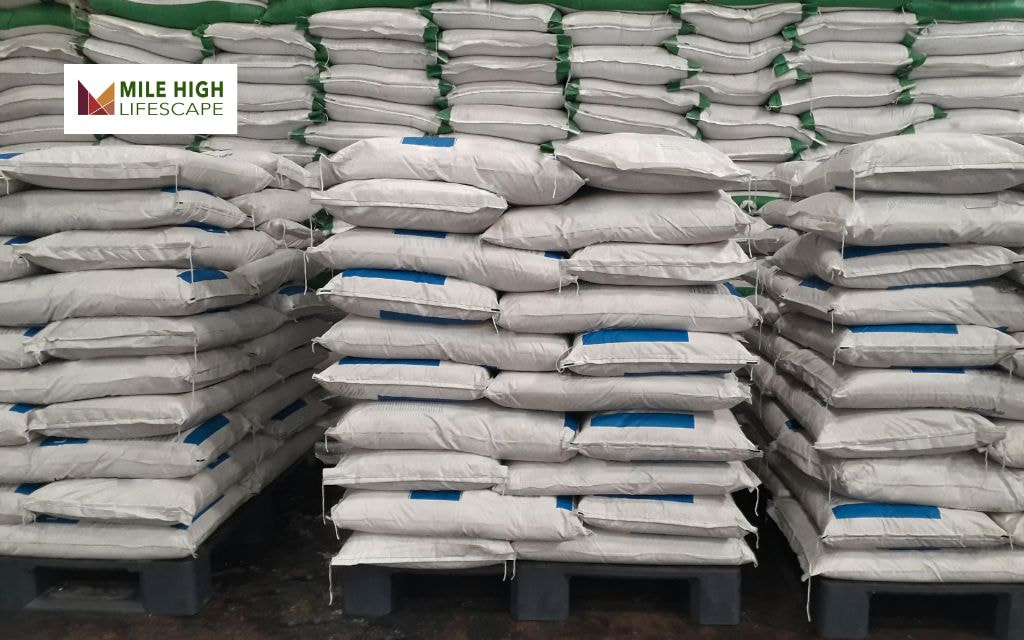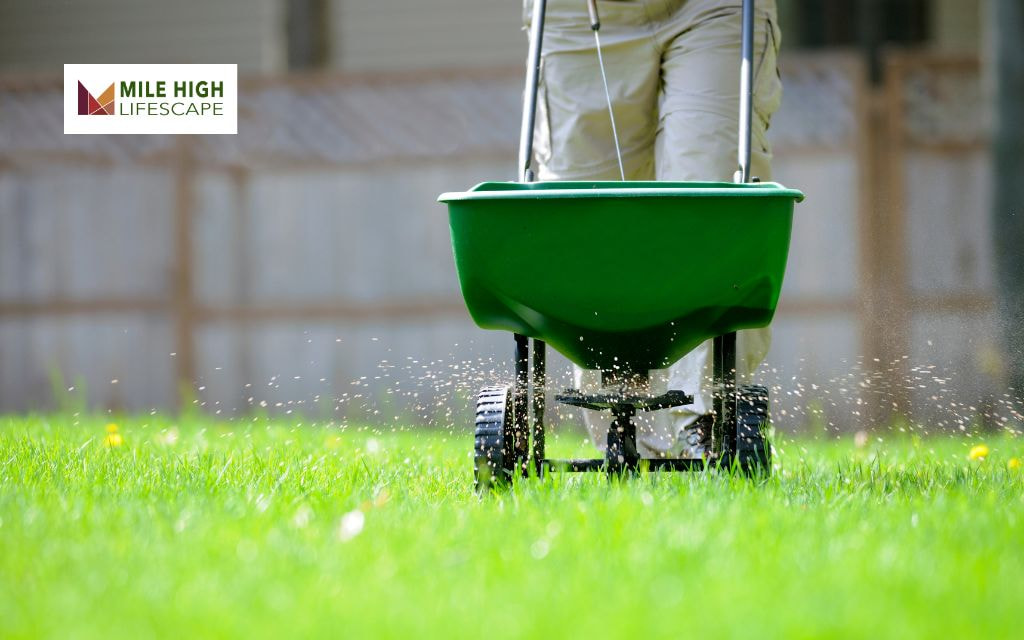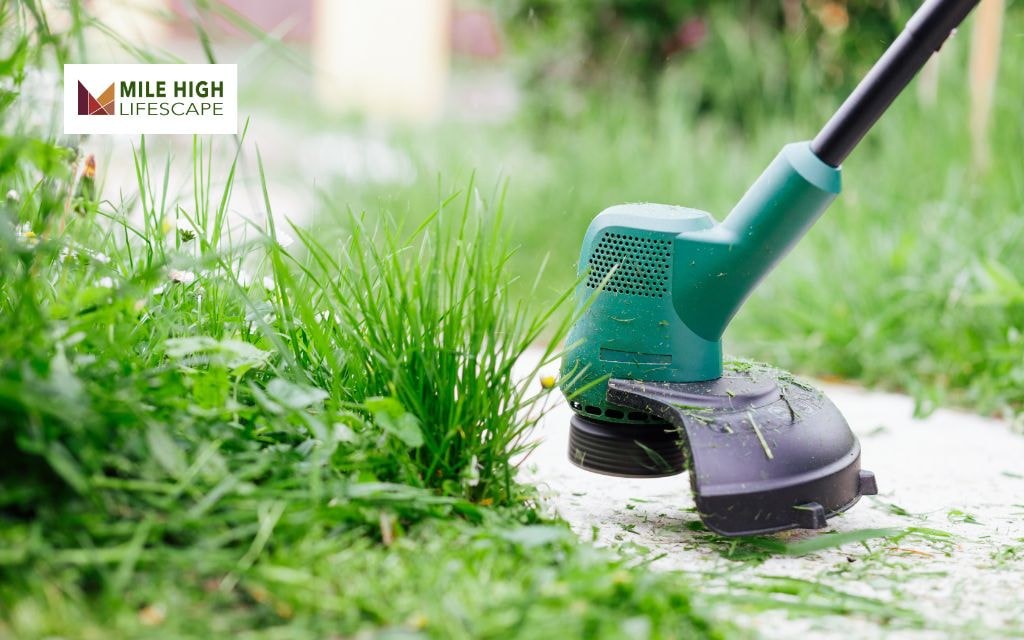Spring marks the awakening of your dormant lawn – but will your grass struggle or thrive in the months ahead? The brutal truth: winter has stripped your soil of critical nutrients, and your starving grass cannot recover without intervention.
Did you know the wrong spring feeding can actually weaken your grass before summer stress hits? Or that using the wrong fertilizer formula might be why your neighbor’s lawn always outshines yours?
This guide cuts through marketing hype to reveal exactly when to fertilize in spring, which formulas actually work for Colorado lawns, and application secrets professionals don’t want you to know. Let’s dig in!
Understanding Lawn Fertilization
Lawn fertilization delivers essential nutrients directly to your soil, supporting critical growth processes your grass needs to develop density, color, and disease resistance. The three primary nutrients found in most fertilizers include:
- Nitrogen (N) – Promotes leaf growth and rich green color by stimulating chlorophyll production.
- Phosphorus (P) – Develops strong root systems and supports energy transfer within the plant.
- Potassium (K) – Enhances disease resistance, drought tolerance, and overall stress recovery
These nutrients appear as numbers on fertilizer packaging (like 10-10-10 or 29-0-4), representing the percentage by weight of each element. Different ratios address specific lawn conditions and seasonal needs. For spring applications, nitrogen-focused formulations typically take priority to encourage the flush of new growth after winter dormancy.
When to Fertilize Your Lawn in Spring?
Timing your spring fertilization correctly maximizes nutrient uptake and minimizes waste, but the optimal window varies based on your climate zone and grass type.
For a detailed breakdown, check out this lawn care spring schedule to plan your seasonal tasks effectively.
Local soil temperature, rather than calendar date, should guide your fertilization schedule. In Denver’s climate, early spring applications often occur in late March to mid-April, while late spring feedings happen in May.

Early Spring (February-April)
For cool-season grasses, apply a light fertilizer application when the soil temperature consistently reaches 55°F.
This early feeding helps recover from winter damage while providing a moderate growth boost. Use a fertilizer with a controlled-release formula to prevent excessive top growth that depletes energy reserves.
Late Spring (April-June)
The second spring application typically occurs 6-8 weeks after the initial feeding, when your lawn has fully greened up and begun active growth. For warm-season grasses like Bermuda or Zoysia, this represents the primary spring feeding as these varieties enter peak growth once soil temperatures consistently exceed 65°F. This application builds reserves for the demanding summer months ahead.
Choosing the Right Spring Lawn Fertilizer
The ideal spring fertilizer varies significantly based on your grass type and specific lawn conditions:
| Grass Type | Climate | Recommended Spring N-P-K Ratio | Key Features |
| Cool-Season (Kentucky Bluegrass, Fescue, Ryegrass) | Northern regions, Denver metro | 20-5-10 or 24-4-8 | Higher nitrogen for spring growth |
| Warm-Season (Bermuda, Zoysia, St. Augustine) | Southern regions | 15-0-15 or 16-4-8 | Balanced nitrogen and potassium |
Slow-Release vs. Quick-Release Fertilizers
Spring applications benefit from combining both quick and slow-release nitrogen sources. Quick-release nitrogen (from ammonium sulfate or urea) provides immediate greening, while slow-release forms (like sulfur-coated urea or organic compounds) extend feeding for 6-8 weeks. Quality spring fertilizers typically contain 30-50% slow-release nitrogen to prevent growth surges that weaken grass.
Organic vs. Synthetic Options
Organic fertilizers like compost, manure, and products containing bone meal release nutrients gradually as soil microbes break them down. These build soil health over time but work more slowly, especially in cool spring soils.
Synthetic fertilizers deliver precise nutrient ratios immediately but don’t improve soil structure. For spring applications in Colorado, a synthetic starter fertilizer with some slow-release nitrogen often provides the balanced approach most lawns need.

How to Apply Spring Lawn Fertilizer Properly
Proper application techniques ensure even distribution while preventing waste and environmental harm:
- Test your soil before fertilizing – Soil tests identify existing nutrient levels and pH imbalances, preventing over-application of unnecessary elements. Many extension offices offer affordable testing services.
- Calculate the correct amount – Measure your lawn area and follow package instructions for application rates, typically listed as pounds of nitrogen per 1,000 square feet (usually 0.5-1 lb for spring applications).
- Prepare your lawn – Mow the grass and remove debris before fertilizing. Apply to dry grass but ensure soil moisture is adequate.
- Use the right equipment – Broadcast spreaders distribute fertilizer in a wide pattern ideal for large areas, while drop spreaders provide precise control along borders and near gardens. Calibrate your spreader according to manufacturer specifications.
- Apply using a consistent pattern – Work in straight, slightly overlapping lines across your lawn. Apply half the fertilizer in one direction, then the remaining half in perpendicular passes for even coverage.
- Water properly afterward – Irrigate with 1/4 inch of water immediately after application to wash granules off grass blades and into the soil, preventing fertilizer burn.
Avoid application before heavy rain forecasts to prevent runoff into local waterways. For Denver homeowners, spring winds can also displace fertilizer, so choose a calm day for application.
Summer, Fall, and Winter Lawn Fertilization Guide
Summer Lawn Fertilization (June-August)
During the hot summer months, your fertilization approach should shift from promoting growth to maintaining resilience. High temperatures reduce growth rates for cool-season grasses while accelerating it for warm-season varieties.
For cool-season lawns common in Denver (Kentucky Bluegrass, Fescue), limit summer fertilization or skip it entirely when temperatures consistently exceed 85°F. Excessive nitrogen during heat stress forces growth that depletes energy reserves when the plant needs to conserve resources.
If fertilization proves necessary due to nutrient deficiencies:
- Choose a fertilizer with lower nitrogen content (around 10-15%)
- Select formulations with higher potassium levels (the third number in the N-P-K ratio)
- Apply at 50-75% of the spring rate to avoid pushing excess growth
- Water thoroughly after application to prevent fertilizer burn

Fall Lawn Fertilization (September-November)
During fall, cool-season grasses shift energy from blade growth to root development and food storage. Nutrients applied during this period strengthen root systems, improve winter hardiness, and create reserves for early spring green-up.
Early Fall (September)
Apply a balanced fertilizer with an N-P-K ratio like 24-4-12 or 22-0-10 when temperatures moderate but before the first frost. This supports recovery from summer stress and promotes robust root development.
Late Fall (October-November)
The final fertilization of the year should occur just before the grass stops growing but while it remains green. In Denver, this typically falls between late October and early November.
For this application:
- Choose a fertilizer with higher nitrogen content (25-0-10 or similar)
- Look for predominantly slow-release nitrogen sources
- Aim for application when growth slows but before ground freezes
- Apply at a rate of 1-1.5 pounds of nitrogen per 1,000 square feet
Winter Lawn Fertilization (December-February)
When soil temperatures drop below 40°F, grass enters complete dormancy. During this period:
- Root uptake of nutrients dramatically decreases
- Microbiological activity that breaks down fertilizer slows or stops
- Applied nutrients often remain unused until spring thaw
- Risk of runoff increases with frozen or snow-covered ground
Instead of winter fertilization, focus on:
- Minimizing winter lawn traffic to prevent damage to dormant grass
- Clearing leaves or debris that might smother grass or harbor disease
- Applying anti-desiccant sprays in exposed areas prone to winter burn
- Planning your spring fertilization program based on fall soil test results
Additional Lawn Care Tips for Spring
Fertilization works best as part of a comprehensive spring lawn care regimen:
- Core aeration before fertilizing improves nutrient penetration and reduces soil compaction from winter. This process removes small plugs of soil, allowing air, water, and nutrients direct access to root zones. Learn more about lawn aeration in Colorado Springs to optimize your spring prep in this region’s unique conditions.
- Overseeding thin areas in conjunction with fertilization provides ideal conditions for new seedlings. Choose grass varieties compatible with your existing lawn and suited to Denver’s climate and sunlight conditions. For best results, discover tips on seeding a lawn in spring to ensure strong germination and growth.
- Maintain proper mowing height during spring transition – typically 2.5-3.5 inches for most cool-season grasses in Denver. Gradually lower cutting height from winter settings, never removing more than one-third of the blade length in a single mowing.
- Balance irrigation with rainfall, typically providing 1-1.5 inches of water weekly, including precipitation. Water deeply and infrequently to encourage deep root development. Moreover, understanding the best time to start watering lawn in spring complements your fertilization strategy for optimal results.
To maximize your lawn’s health, explore how to take care of your lawn in spring with practical steps tailored to the season.

Environmental Considerations
Responsible fertilization minimizes environmental impact:
- Apply fertilizer only where needed—keep it off driveways, sidewalks, and streets where it can wash into storm drains and contaminate waterways. Use a spreader with a shield or edge guard when fertilizing near hardscapes.
- Consider phosphorus-free formulations (the middle number in N-P-K) unless soil tests indicate deficiency, as this nutrient poses the greatest risk to water quality.
- Slow-release nitrogen sources reduce leaching into groundwater. For Denver’s varied topography, this becomes especially important in areas with slopes or drainage concerns.
- Incorporate organic matter like compost into your annual lawn care program to improve soil structure, reducing the overall need for synthetic fertilizers while enhancing nutrient retention.
Conclusion
Strategic spring fertilization establishes the foundation for a healthy, resilient lawn throughout the growing season. By selecting the right spring lawn fertilizer formulation for your grass type, timing applications based on soil temperature rather than calendar dates, and using proper application techniques, you’ll maximize results while minimizing environmental impact.
For Denver homeowners, adapting these principles to our unique climate conditions – including altitude, low humidity, and temperature fluctuations – ensures your lawn receives the nutrition it needs when it can use it most effectively. With proper spring feeding, your lawn will develop the deep roots and dense growth necessary to withstand summer heat and drought stress in the months ahead.
If you’d rather leave it to the pros, explore Denver spring lawn care services from Mile High Lifescape tailored to your local needs.
Frequently Asked Questions (FAQs)
What fertilizer should I use on my lawn in the spring?
For cool-season grasses common in Denver, choose a fertilizer with a ratio like 20-5-10 or 24-4-8 with approximately 30-50% slow-release nitrogen. For warm-season grasses, a balanced 15-0-15 or 16-4-8 formulation works best.
What is the best feed for lawns in spring?
The best spring lawn feed contains predominantly nitrogen with some potassium and minimal phosphorus unless a soil test indicates phosphorus deficiency. Look for products specifically labeled for spring application with both quick and slow-release nitrogen sources.
What fertilizer numbers to use in spring?
For established lawns, spring fertilizer ratios like 20-5-10, 24-4-8, or 29-0-4 provide appropriate nutrition. The higher first number (nitrogen) promotes green growth, while the last number (potassium) supports stress tolerance.
When should I apply 10-10-10 fertilizer to my lawn?
While 10-10-10 is a balanced fertilizer, it’s generally not ideal for spring lawn applications as it contains more phosphorus than typically needed. If soil tests indicate deficiencies in all three nutrients, apply it when soil temperatures reach 55°F, usually in mid-April in the Denver area.
Is 13-13-13 fertilizer good for lawns?
Similar to 10-10-10, the balanced 13-13-13 formula provides more phosphorus and potassium than most established lawns require in spring. It’s better suited for newly seeded areas or lawns with confirmed deficiencies in all three macronutrients.
Do you apply fertilizer to wet or dry lawn?
Apply fertilizer to dry grass but slightly moist soil. This prevents granules from sticking to wet grass blades while ensuring enough soil moisture for initial nutrient dissolution. Water thoroughly immediately after application to activate the fertilizer and move it into the root zone.
